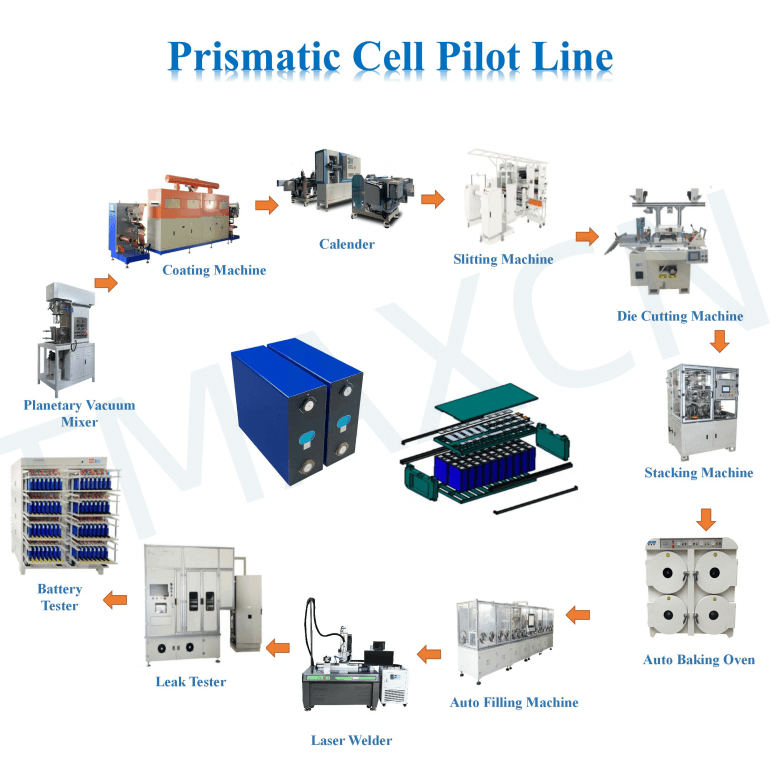Site Blog
contact us
- If you have questions, please contact us, all questions will be answered
- Email : David@tmaxcn.com
- Email : Davidtmaxcn@gmail.com
- Add : No. 39, Xinchang Road, Xinyang, Haicang Dist., Xiamen, Fujian, China (Mainland)
hot products
Here is a more detailed description of the production technology involved in a EV Car battery pilot plant
Material preparation
Positive electrode materials Prepare the active materials, conductive additives, and binders required for the positive electrode.
Negative electrode materials Prepare the active materials, conductive additives, and binders required for the negative electrode.
Electrolyte Prepare the electrolyte solution with the appropriate composition and concentration.
Separators Prepare the separators, typically made of porous materials that allow ion flow while preventing electrical contact between the positive and negative electrodes.EV Car cell pilot machine
Cell component fabrication
Coating Apply the positive and negative electrode materials onto metal foils using a coating technique, such as doctor blade or slot-die coating.
Drying Dry the coated electrodes to remove solvents and ensure proper adhesion of the active materials.
Calendering Apply pressure to the electrode films to enhance their density and mechanical properties.
Slitting Cut the coated and dried electrodes into specific widths to match the desired cell dimensions.
Stack assembly Alternate layers of positive and negative electrodes separated by the prepared separators to form a multilayer stack.
Tab welding Connect the electrode tabs with conductive metal tabs for electrical contact.
Cell formation
Cell stacking Stack multiple electrode assemblies together, interleaved with additional separators, to form a complete cell stack.
Cell housing Place the cell stack into a suitable housing, typically made of metal or polymer, to contain the electrodes and electrolyte.
Sealing Seal the cell housing to ensure a hermetic and leak-proof enclosure.
Filling Inject the electrolyte into the cell housing to impregnate the electrodes and separators.
Cell assembly
Terminal attachment Connect the positive and negative terminals of the cell to external contact points for electrical connectivity.
Battery management system (BMS) Integrate a BMS that monitors and controls the charging, discharging, and overall performance of the battery pack.
Module assembly Combine multiple cells into modules, typically interconnected in series and parallel configurations, to achieve the desired voltage and capacity.
Testing and quality control
Performance testing Conduct thorough testing to assess key performance parameters such as capacity, voltage, internal resistance, cycle life, and safety characteristics.
Quality inspection Perform visual inspection, dimensional measurements, and electrical testing to ensure the cells and modules meet the required quality standards.
Data analysis Collect and analyze data from the testing and inspection processes to identify any deviations, optimize the production parameters, and improve product quality.
Process optimization and improvement
Continuous monitoring Implement real-time monitoring systems to track and analyze process parameters, enabling timely adjustments and optimization.
Feedback loop Incorporate feedback from testing, quality control, and customer feedback to identify areas for improvement and implement corrective actions.
Research and development Invest in research and development activities to explore new materials, manufacturing techniques, and process innovations for enhanced cell performance and cost efficiency.
By following these detailed production steps, a EV Car battery pilot machine
can produce high-quality prismatic cells for evaluation, validation, and optimization before scaling up to large-scale production.
 ru
ru

 Iris@tmaxcn.com
Iris@tmaxcn.com David@tmaxcn.com
David@tmaxcn.com +86 13174506016
+86 13174506016 18659217588
18659217588